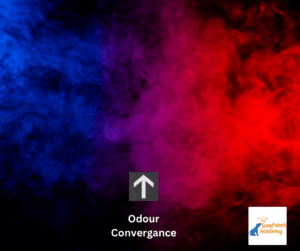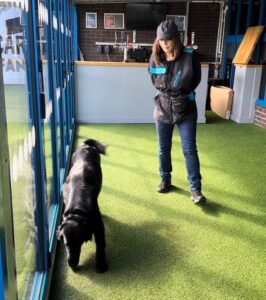“No sorry.” Two words no dog detection handler ever wants to hear, especially when a crucial trial qualification hangs in the balance. It’s a gut punch! But here’s the fact, dogs make mistakes, and so do we. Having seen thousands of searches and said those disheartening words more times than I can count over the past few years, I want to delve deeper into the common reasons dogs give a false indication, leading to a “wrong alert” in a blind find scenario.
Now, a quick but important disclaimer – Just like in my other article posts, I’m not talking about operational detection dogs here. Their training path can be very different depending on the task they are being trained for and indeed the dog’s genetics and learning history will not be the same compared to dog owners stepping into hobbyist/sporting detection with their companion pet dog.
I often get asked, “Why did my dog do that?” While I’m not a dog mind reader, my experience allows me to offer some insights for pet detection dog handlers to ponder. Becoming more aware of your own dog’s behaviour’s around this topic can be incredibly helpful. So, where should we begin? Let’s kick things off by looking at the odour itself
The Odour Element
Pooling odour – Pooling odour presents a significant challenge for scent detection dogs. When scent molecules accumulate in one area, they can distort the true scent picture, making it more challenging for the dog to track to the actual source. This often results in false indications. Think of how smoke might rise and gather in a room, clinging to walls and filling a nook. To a dog, this strong, more concentrated scent can be misleading, even if the source is elsewhere, leading to a ‘fringe’ indication.
Fringing – When a dog is not indicating at the actual source, this is termed as fringing; it means they’re indicating a stronger concentration of odour that they were in, but not precisely at it. The dog has encountered an increase in scent strength and commits to an indication too soon. An experienced handler understands their dog is very close and will give them more time to pinpoint the exact origin of the strongest odour.
Residual odour – is the faint, leftover scent from a substance that was there but no longer is. It’s particularly prevalent with oily compounds that penetrate porous items like wood or fabrics. Uncleaned areas can also harbour traces of previous target odours. The growing use of scent containers or shells is a great solution, helping to eliminate this problem.
My philosophy is that while advanced dogs can learn to effectively navigate and ignore fading residual odours, it’s vital for novice dogs to train in the cleanest possible environment. Removing residual scent ensures they’re not confused and they are set up for success.
Previous hides left out – What more can I say, human error, it’s there. Dogs’ noses are sensitive. It’s a find, not a false indication.
The Training Element
Introducing distraction scents early in sports scent detection training is becoming standard practice. These can be a wide array of smells, including toys, metals, plastics, food, trainer and owner scent or even organic materials like animal hair, the list is truly endless The core principle is simple, we want the dog to ignore everything except the specific target odour they’re trained to find.
If a dog hasn’t been exposed to other odours in a search area, these distractions can easily lead to intense investigation behaviours sometimes leading to a wrong alert by the handler or a dog might indicate on carrier materials like velcro, fabrics, metal slider tins, or plastic casings (shells/scent carriers) all of which have their own inherent smell that was as been part of the overall scent picture previously for the dog on successful finds.
Therefore, using distractions is a crucial part of the training process, helping to proof your dog’s odour obedience to just the target odour above all else in the environment
Overemphasizing Indication Training
I’ve noticed a common pitfall leading to false indications, particularly with novice dogs, when training is heavily baised on training an operant the final response (TFR) behaviour, overriding the dog’s fundamental motivation and joy for the search itself. There’s a crucial balance here. If a dog has been strongly reinforced for an indication behaviour not genuinely linked to the search game, they might start indicating on “blanks”. The dog may find getting to source difficult so opts for the behaviour they have previously received a high rate of reinforcement for. I have found this to be seen more often seen in item searches than area searches. Thankfully, this behaviour is usually short-lived once the dog realizes no reinforcement is coming.
Clear Areas – No Target Odour
Another cause of false indications is when the dog is always anticipating a ‘find’ and clear searches have not been experienced. The dog, in desperation will indicate to seek reinforcement, as this is what they know.
The Dog Element
Dogs have incredible memories, and this can sometimes work against us during scent work. If your dog has found a hide in a particular spot before and received positive reinforcement, they might return to that same spot and indicate, even if there’s no scent there this time. They’re simply remembering a past success! That’s why varying your hide placements is crucial to prevent your dog from “ghosting” old spots and to ensure they’re truly searching for the scent
A demotivated dog is also more likely to give false indications. Why might a dog be demotivated? It could be due to a variety of factors – See below.
Confusion – Your dog might simply be unsure of what’s expected of them. The task is possibly too difficult so the dog falls back on a behaviour they do know how to do.
Frustration – If they’re struggling to understand the task or locate the scent, frustration can set in often seen in displacement behaviours such as environmental sniffing, barking, trashing/playing, body scratching and/or a false indication.
Physical Discomfort – Just like us, dogs can be affected by their physical state. Fatigue, thirst, hunger, or even pain can lead a dog to indicate falsely, simply because they want to finish the search sequence seeking relief. (We’ll also touch on “The Handler Element” and how your actions can play a role below).
It’s vital to be mindful of these possibilities. If your dog is underperforming or displaying unusual behaviours, it’s may not always a training issue. Often, there’s an underlying reason physical or emotional, that needs to be addressed.
The Handler Element
Handler Body Languages – A dog can learn to associate their handler’s body position with finding the target odour. If a handler consistently adopts the same stance every time their dog locates the scent, this stance can become a part of the dog’s overall picture of a successful find. For example, a static position might not be the only cue for a dog to indicate, but when combined with other factors, like the scent pooling in an area or the dog not being exactly at the source, the handler’s consistent positioning can act as a perceived confirmation for the dog. This can then trigger a false indication, even if the dog isn’t truly on the target.
Reaching for the Reward – Another common scenario for a false or premature indication occurs when the dog anticipates the reward. If the dog sees the handler’s shoulder, arm, or hand move to retrieve the primary reinforcer (the reward) prior to the marker word is given, the dog might indicate too early or break their current indication to then re-indicate, even if they aren’t directly at the source. The dog associates the handler’s movement with the impending reward and responds accordingly.
Handler Pressure – Dogs are highly attuned to their handlers emotions, and subtle or overt pressure can influence their behaviour. If a dog feels pressure from the handler, whether it’s physical proximity (being too close to the dog) or constant redirecting to a specific area or item, they may offer an indication because they believe it’s what the handler wants. You may have heard this referred to as “talking your dog into it” or over-verbalizing. The dog might display their indication behaviour out of a desire to please or due to confusion and frustration, rather than because they’ve genuinely found the target odour.
Understanding these handler-related factors is crucial for minimizing false indications. A great way to pinpoint areas for improvement as a scent detection handler is to record video footage of yourself while your dog searches. Reviewing these videos can highlight subtle cues or behaviour’s you might be unconsciously giving that influence your dog’s indications
While false indications can be incredibly frustrating, I hope this discussion offers a fresh perspective on your own experiences. Like every aspect of scentwork training, it’s a journey, and we can truly learn from every behaviour our dogs show us during a search.
Our role is to support their success in training. In my view, if our dogs are engaged in the search game, they’re always trying their best. Therefore, false indications are simply a natural part of every team’s journey in this sport.
Mandy Rigby – Article from a social media awareness post July 2025
Founder of Canine Scentwork Academy Est. 2017





